2016 Fall
|
THE WINTER 2016 MAP is now active. All but one (Leif) of our flock have settled down for the winter. One cell-tower bird (Hackett) is hiding, maybe in Cuba, and his mate Holly is getting very sporadic contact in far eastern Brazil. Don't forget to refresh your browser to be sure to catch the latest updates (below the map).
|
All Birds - Fall 2016 (15 Aug - 20 Dec)Holly (black), Adult female tagged with her mate, Hacket, at her nest in Annapolis, MD. on 3 May 2016. Began migration 29 Aug finished 16 Oct. Hackett (dk blue), Adult male trapped at his Annapolis, MD, nest along with his mate, Holly, on 3 May 2016. Began migration 27 Aug. Missing in cell-tower limbo. Staddler (pale blue), Adult male, began migration on 5 Sept (last year 30 Aug). Home onthe Amazon River in Brazil 13 Oct. Wausau (aqua) Adult male, Began migration 4 Sep (last year 11 Sep). Home in Colombia 5 Oct. Belle (pink), Martha's Vineyard 6-yr old male(?). Began migration 21 Sep (last year 15 Sep). Nick (red), Adult male, tagged in 2013. Began migration on 29 Sep (last year 18 Sep). Home in Colombia 15 Oct. Flow (green). Essex, MA, 2-yr old male. Began his 2nd migration south on 29 Sep and arrived at his casa in Cuba 8 Oct. Newly tagged in NewfoundlandShanawdithit (dk blue), Adult female, mother of Virginia and Jocelyn. St. John's, Newfoundland. Tagged 24 Aug. Began migration 16 Sep. Virginia (orange), Juv. female, daughter of Shanawdithit. St. John's, NL. Tagged 24 Aug. Began migration 4 Oct. Died 7 Oct in South Carolina. Jocelyn (yellow), Juv. female. St. John's, NL. Tagged 24 Aug. Died after collision on 27 Sep or so. Daphne (white), Ad. female. St. John's, NL. Tagged 25 Aug. Began migration 2 Sep. Maybe done 17 Oct in Panama. Leif Erikson (teal), Juv. male. St. John's, NL. Tagged 25 Aug. Began mirgrating on 15 Sept. Trepassey (gold), Juv. female. Trepassey, NL. Tagged 26 Aug. Last signal 11 Sep. Notes: Hover the cursor over a dot to see which bird is which. Click on it for location details You can zoom in and out and move the map around. If you slide a bird's marker along its path, you'll see where the other birds were when your bird was wherever you have the marker. You can also use the calendar to see where all the birds were on a given date. |
Updates:
(Scroll up for interactive map)
12 December
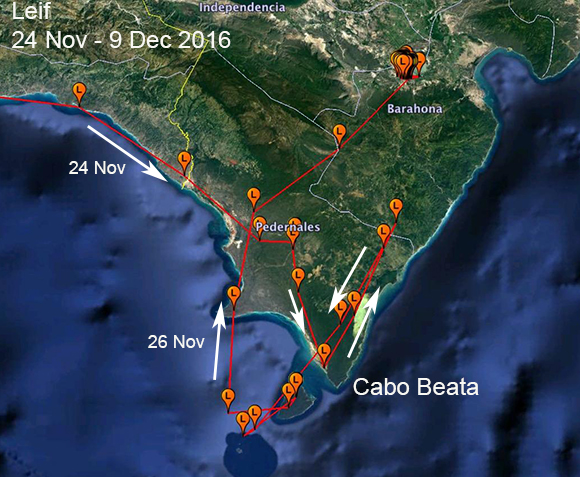 Leif cruised across Cuba and on to Haiti and then followed the coast down to Cabo Beata, launching point for 80% of the adult Ospreys traveling to South America. He looked like a pro! Once he to the tip of the cape he wandered north for a few hours and then it looked like he was going to make the Caribbean crossing. But he apparently got cold feet and changed his mind. He turned around and headed north. Once over land again, he moved up to a large lake Laguna del Rincon. This is one of a series of below-sea-level lakes in a rift valley that runs from Haiti into SW Dominica. We know two of these lakes from following other birds, especially Belle, who stop for refueling at Lakes Azuei and Enriquillo. This looks like a good spot, but we had a bird (Luke) shot here way back in 2007. So it makes me nervous! It's early to call this the end of his migration. We've had a bird stop for three weeks in Florida and then turn on the migration switch again and wind up on the Amazon. So no telling what Leif will do next. A likely scenario, however, is that he'll stay at Rincon for a while and then do some more exploring around the D.R. Stay tuned!
Leif cruised across Cuba and on to Haiti and then followed the coast down to Cabo Beata, launching point for 80% of the adult Ospreys traveling to South America. He looked like a pro! Once he to the tip of the cape he wandered north for a few hours and then it looked like he was going to make the Caribbean crossing. But he apparently got cold feet and changed his mind. He turned around and headed north. Once over land again, he moved up to a large lake Laguna del Rincon. This is one of a series of below-sea-level lakes in a rift valley that runs from Haiti into SW Dominica. We know two of these lakes from following other birds, especially Belle, who stop for refueling at Lakes Azuei and Enriquillo. This looks like a good spot, but we had a bird (Luke) shot here way back in 2007. So it makes me nervous! It's early to call this the end of his migration. We've had a bird stop for three weeks in Florida and then turn on the migration switch again and wind up on the Amazon. So no telling what Leif will do next. A likely scenario, however, is that he'll stay at Rincon for a while and then do some more exploring around the D.R. Stay tuned!
2016 - The year in review:
26 January 2016
It has been a tough winter. Our Fishers Island male Charlie, who surprisingly popped up in December on Hispaniola, settled down at a fish farm in the D.R. and was almost certainly shot there. We had a couple of days of locations at the same spot at the edge of the fish farm and then nothing after 19 Dec., so we're pretty sure we lost him.
Prior to losing Charlie, we lost our signal from N.H. male Donovan on 10 November. He was in an apparently remote area where he's spent the winter before, so we don't know what might have happened to him. Then we lost a newly tagged N.H. male, Gundersen, whose last satellite update was on 12 January. Neither Donovan nor Gundersen showed a lot of transmissions from one spot, which is alway a sign of a dead bird, so we can hold onto a glimmer of hope that they'll show up at their nests in the spring, but experience tells us to expect the worst.
4 March 2016
Our favorite Osprey, Belle, is on the move! She's 4 days earlier than last year. Each year she has left earlier than the year before. Her first trip north, way back in 2012, began on Apr 13. The next year it was 25 Mar, then 14 Mar, then 8 Mar in 2015, and now 4 Mar. Maybe this year she'll get home in time to find Mr. Right. Talons crossed!
Edwin popped up in Venezuela. As in the past two summers, he wintered somewhere in the Amazon out of range of cell towers. In the 2013-14 and 2014-15 winters he was at the same spot along the Amazon. No reason to believe that this winter was different, and in fact there is every reason (every other adult Osprey we have followed) to believe that he went to the same spot. Last year he left his winter HQ very earlier (2 Feb) than any other bird we've followed. But he got up into southern Venezuela and then circled back and spent several weeks stalled out before heading north for real. This year he's 11 days ahead of last year's timetable.
Snowy will be very interesting to watch. She's the first bird we've seen with two winter homes--one in Cuba, where she is now, and one in Venezuela. Last year she wintered in Venezuela and left there on 20 Feb. This year, it's already 4 March and she hasn't started north. It was on March 4th last year that she got to her Cuban winter spot (where she is now). She stopped there for 27 days, starting the final push north on 31 March. This suggests that she somehow knows how far she is from home and thus when it's appropriate for her to start north.
Flow is gearing up for his first trip north after his 18-month stay in Cuba. First timers usually start late, so we don't expect him to move soon, but just stating this means he'll probably leave tomorrow! Talons crossed that he avoids fish farms in Cuba and Great-horned Owl woodlots on his way north.
25 March 2016
Lots going on as all the adult birds are now on the wing or already home (Snowy and Edwin). Colors changed on the map again when Quin reappeared from his winter in Cuba.
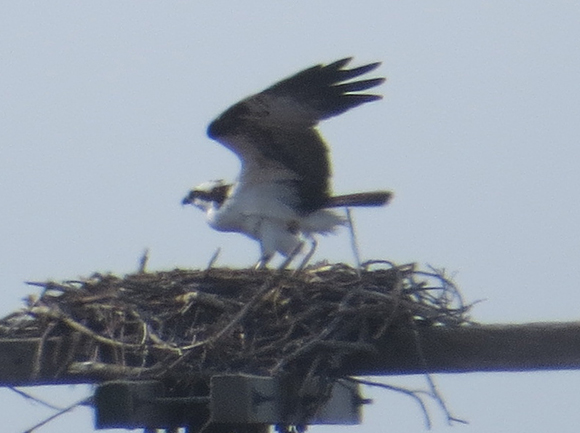 Snowy's transmitter (deployed way back in 2011) is beginning to fail. We missed an upload, but we have eyes on Snowy as he (see below) is trying to take over a nest on Nantucket. We've got pictures of him on the pole after he missed his upload, so we know it's the PTT, not the bird that's having problems. In this picture (taken by Trish Pastuszak), the antenna isn't visible, but it's obvious in another shot. This one shows a snow-white belly which makes me change my mind yet again on Snowy's gender. We first thought he was a male and then changed our minds based on his very early August departures--very much a female thing. But now he's back very early and looking very male. And very well fed. He has a huge crop (the big bulge in his chest) in this picture, which tells us he's just eaten a pretty big fish.
Snowy's transmitter (deployed way back in 2011) is beginning to fail. We missed an upload, but we have eyes on Snowy as he (see below) is trying to take over a nest on Nantucket. We've got pictures of him on the pole after he missed his upload, so we know it's the PTT, not the bird that's having problems. In this picture (taken by Trish Pastuszak), the antenna isn't visible, but it's obvious in another shot. This one shows a snow-white belly which makes me change my mind yet again on Snowy's gender. We first thought he was a male and then changed our minds based on his very early August departures--very much a female thing. But now he's back very early and looking very male. And very well fed. He has a huge crop (the big bulge in his chest) in this picture, which tells us he's just eaten a pretty big fish.
Edwin is back in southern Connecticut. We're hoping this year he'll get back to breeding. Last summer he spent a lot of time over on Gardiners Island. Watch for him to swing over there and check out the nest poles he was prospecting last year.
Nick and Quin only have to make it to Chesapeake Bay, so they should be home soon. The New Hampshire boys, Wausau and Staddler, still both in South America, better get a move on as they are missing out on an early spring up in central New England.
We're all pulling for Belle to get a move on and finally find Mr. Right. She last checked in (23 March) in central Florida. If the weather's been good, she should be in Georgia or South Carolina by now.
2014 juvenile Flow from northeastern Massachusetts is just a teenager, so we don't really expect him to wake up before noon, which translates in Osprey to begining his first migration north some time in April.
10 April 2016
All our adult birds except Wausau and Quin are home. Quin dropped off our radar screens over coastal Georgia back on 28 March. We'll watch his nest to see if he's there with a malfunctioning transmitter, but experience tells us that he probably died. With cell-tower birds we often can't tell what happened to them because they may have moved a long way after their last check-in.
Snowy left Cuba on the 12 March and arrived on the Cape seven days later. He went pretty much straight over to Nantucket, where he spent quite a bit of time last summer. Part of his antenna seems to have broken off, so he's OK, but we now only will hear from him when he happens to show up at a nest where someone notices him. He's been reported (and photographed) at two nests on Nantucket where he settled down with a female and was subsequently run off, probably by the resident males returning to that nest.
Belle is mostly over on the Cape, but has made two trips to Martha's Vineyard. We don't see her hanging out at a nest platform, so this may not be the year she finds Mr. Right.
Edwin's trip from the Brazilian rainforests began on 27 February and finished on 23 March. He spent some time at nest poles on Gardiners Island in Long Island Sound. He visited these poles last summer. This seems to be a pattern. Young birds will begin staking out possible nest sites in the summer and try them out the next spring, hoping that the owner doesn't make it back from the wintering area. He's now gallavanting around Connecticut, with no obvious fidelity to a possible nest site.
Staddler left his wintering area on 19 March and arrived at his nest in coastal NH on the 6th of April in an impressive 18 days, averaging 221 miles/day--a bird on a mission!
Nick left the Magdalena River valley in northern Colombia on 18 March and arrived at Tangier Island in Chesapeake Bay on the 30th. Since then he's been spending quite a bit of time over in Virginia on the western shores of the Bay.
Our 2014 juvenile Flow is still down in Cuba, where he has been for about 18 months. This will be his first trip north, and typically, young start their first trips in late April or even early May.
21 April 2016
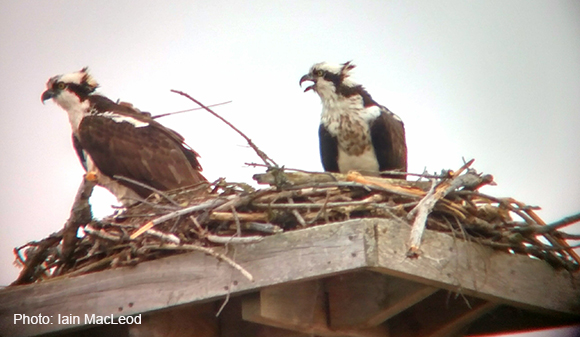 Wausau arrived at this nest in northern New Hampshire on the 18th. His arrival and the ensuing battle to resume ownership of "his" nest from a pretender to his throne was documented by Iain MacLeod, my partner in NH Osprey tagging. Wausau won the battle, in a scene reminiscent of what happened to Snowy twice on Nantucket this spring.
Wausau arrived at this nest in northern New Hampshire on the 18th. His arrival and the ensuing battle to resume ownership of "his" nest from a pretender to his throne was documented by Iain MacLeod, my partner in NH Osprey tagging. Wausau won the battle, in a scene reminiscent of what happened to Snowy twice on Nantucket this spring.
Nick, after spending the first week or so after his arrival over on the Virginia side of Chesapeake Bay is now back on Tangier Island full time. We'll try to get eyes on his nest area to see if he'll nest this year.
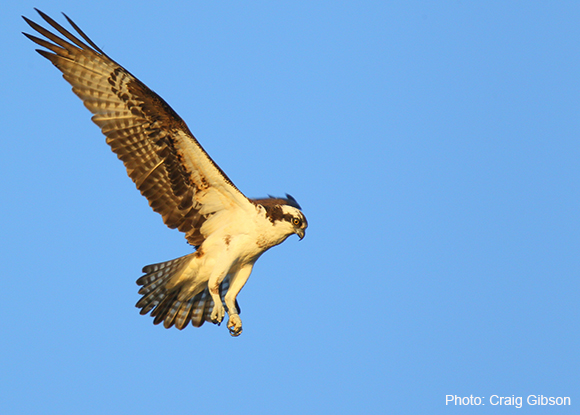
Craig Gibson photographed a tagged Osprey on Cape Cod. The bird is most likely Belle, and if it is, it means Belle is Beau! The bird certainly looks like a male, although it does have a bit of a chest band. The alternative is that it is a bird we tagged earlier in the study. Maybe it's Jaws or Conomo. We haven't seen the kinds of behavior from Belle that I've seen in other young males, where they prosptect for nest sites in the summer.
We'll know for sure when Belle finally finds a mate and settles down at a nest!
We lost the signal from Edwin, our peripatetic male tagged on Fishers Island. Very hard to tell with the cell-tower birds whether they've died or their transmitters have failed. Quin surprised me when he showed up at his nest on Tangier Island a couple of weeks after we got his last signal down in Georgia. With the satellite birds, we get signals from their radios when they stop moving, but if a cell-tower bird dies out of reach of a cell tower, we only know where it was when we got the last signal.
26 April 2016
 Our favorite Osprey gadfly Edwin died around 12 April. Office Joshua Tefft of the CT State Environmental Protection Police came across Edwin's remains while checking out some fishermen on Miller Pond, just north of New London. The body was found about 75 yds from the CT Turnpike (395), with a badly shattered wing. We had high hopes that Edwin would finally settle down and nest, maybe over on Gardiners Island, once (pre-DDT) home to an amazing 300-pair colony of nesting Ospreys. Edwin had spent a fair amount of time prospecting nesting poles on Gardiners over the past two summers. Alas, we won't get to see him settle down and raise a family. On the plus side, we may be able to redeploy his transmitter on another bird.
Our favorite Osprey gadfly Edwin died around 12 April. Office Joshua Tefft of the CT State Environmental Protection Police came across Edwin's remains while checking out some fishermen on Miller Pond, just north of New London. The body was found about 75 yds from the CT Turnpike (395), with a badly shattered wing. We had high hopes that Edwin would finally settle down and nest, maybe over on Gardiners Island, once (pre-DDT) home to an amazing 300-pair colony of nesting Ospreys. Edwin had spent a fair amount of time prospecting nesting poles on Gardiners over the past two summers. Alas, we won't get to see him settle down and raise a family. On the plus side, we may be able to redeploy his transmitter on another bird.
3 May 2016
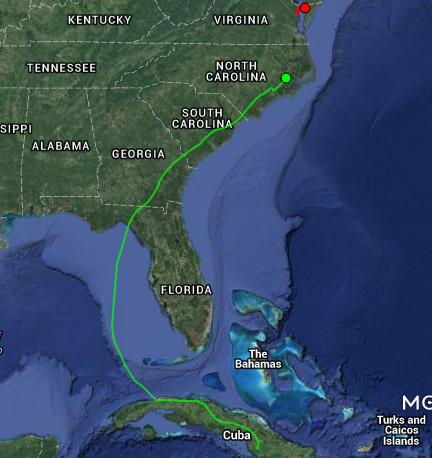 Flow, a male tagged as a juvenile at his nest in Essex Co., MA, finally left his reservoir in central Cuba and is on his way home. He left on 27 April, which was not the latest one of our tagged "teenagers" have started their first trip north (Conomo, another young male who wintered in Cuba, started north on 8 May), but close to it. Flow, like many first-timers before him, missed the turn in Cuba that would have gotten him to the Florida Keys. Instead, he continued west until just past Havanna, where he ran out of land. The shoreline turns southwest at that point, so to continue heading north, he had to cross the Gulf of Mexico, which he did. His crossing was about 520 miles (840 km), arriving on the Florida panhandle south east of Tallahassee in the pre-dawn hours of the 30th. Past the fish farms of Cuba and the dangers of an over-water crossing, he now has to avoid spending the night in a woodlot occupied by a hungry Great-horned Owl as he works his way north to northeastern Massachusetts. He's now in eastern North Carolina and I'm about to head to western NC to teach my ornithology class at the Highlands Biological Station. Our paths won't exactly cross, but it'll be close.
Flow, a male tagged as a juvenile at his nest in Essex Co., MA, finally left his reservoir in central Cuba and is on his way home. He left on 27 April, which was not the latest one of our tagged "teenagers" have started their first trip north (Conomo, another young male who wintered in Cuba, started north on 8 May), but close to it. Flow, like many first-timers before him, missed the turn in Cuba that would have gotten him to the Florida Keys. Instead, he continued west until just past Havanna, where he ran out of land. The shoreline turns southwest at that point, so to continue heading north, he had to cross the Gulf of Mexico, which he did. His crossing was about 520 miles (840 km), arriving on the Florida panhandle south east of Tallahassee in the pre-dawn hours of the 30th. Past the fish farms of Cuba and the dangers of an over-water crossing, he now has to avoid spending the night in a woodlot occupied by a hungry Great-horned Owl as he works his way north to northeastern Massachusetts. He's now in eastern North Carolina and I'm about to head to western NC to teach my ornithology class at the Highlands Biological Station. Our paths won't exactly cross, but it'll be close.
4 May 2016
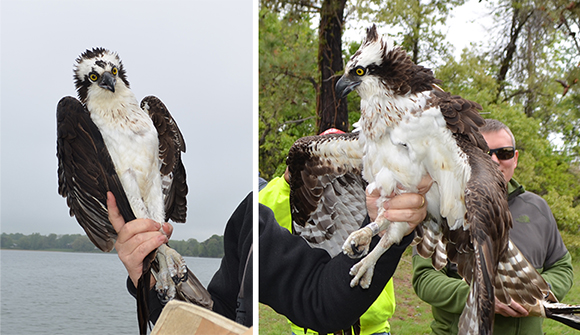 Meet Hackett (on the left) and Holly, a presumably young pair of Ospreys that has set up on a new pole on Hackett Point just south of the Annapolis end of the Chesapeake Bay Bridge. The pole they're on is a replacement for the pole that our 2013 male, Woody, and his mate used. That pole, already at a 45-degree angle, was swept away by ice floes in the winter of 2014-2015. Inexplicably, Woody returned to the Bay last year but did not nest. A pair was in residence when he arrived--perhaps the two birds we trapped and tagged on 3 May of this year--and he was not willing (unlikely) or able (also surprising as the resident male) to reclaim his corner of the Bay. He died later that summer, presumably a traffic fatality. When we arrived this spring to set our trap, the two birds at the replacement pole had not yet laid eggs. I've never trapped adults at a nest without eggs or young, so I was more than a bit skeptical of our chances of catching even one of the pair. We went ahead and set the noose carpet over 3 dummy Osprey eggs (imagine the female's surprise when she returned to the nest to see it full of eggs. Hmmm, she thought, now that was easy!) and 3 menhaden (one of the Osprey's favorite prey items). Oh, ye of little faith! 18 minutes after we pulled away from the nest, we had trapped both birds! We outfitted both of them with cell-tower transmitters and will now get to watch to see how they do this season. It's quite late to be laying, but if this is a young pair, that's not too unusual. Because we've got both the male and female tagged, it will be easy to tell if she lays eggs. Once that happens, almost all her locations will be at the nest.
Meet Hackett (on the left) and Holly, a presumably young pair of Ospreys that has set up on a new pole on Hackett Point just south of the Annapolis end of the Chesapeake Bay Bridge. The pole they're on is a replacement for the pole that our 2013 male, Woody, and his mate used. That pole, already at a 45-degree angle, was swept away by ice floes in the winter of 2014-2015. Inexplicably, Woody returned to the Bay last year but did not nest. A pair was in residence when he arrived--perhaps the two birds we trapped and tagged on 3 May of this year--and he was not willing (unlikely) or able (also surprising as the resident male) to reclaim his corner of the Bay. He died later that summer, presumably a traffic fatality. When we arrived this spring to set our trap, the two birds at the replacement pole had not yet laid eggs. I've never trapped adults at a nest without eggs or young, so I was more than a bit skeptical of our chances of catching even one of the pair. We went ahead and set the noose carpet over 3 dummy Osprey eggs (imagine the female's surprise when she returned to the nest to see it full of eggs. Hmmm, she thought, now that was easy!) and 3 menhaden (one of the Osprey's favorite prey items). Oh, ye of little faith! 18 minutes after we pulled away from the nest, we had trapped both birds! We outfitted both of them with cell-tower transmitters and will now get to watch to see how they do this season. It's quite late to be laying, but if this is a young pair, that's not too unusual. Because we've got both the male and female tagged, it will be easy to tell if she lays eggs. Once that happens, almost all her locations will be at the nest.
4 June
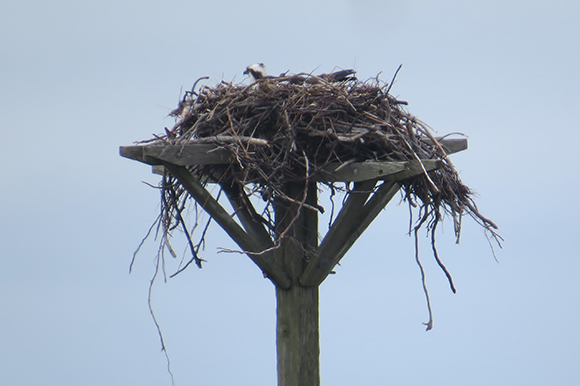 Finally! A picture of Snowy apparently incubating on his nest over on Nantucket. We're so excited. This is our first tagged young to have made it to breeding. Sadly, our latest report from Nantucket indicates that there are no longer eggs or young in the nest. But Snowy is hanging around, so he should return next year to try again.
His antenna broke off (one can just see the base of it protruding from the transmitter on his back) so we aren't getting signals from him, but Trish Pastuszak has been watching and providing a play-by-play summary, as well as photos, of the action at his new nest. We may get over to Nantucket this summer and see if we can retrap him and relieve him of the transmitter. Normally I'd just swap the transmitter for a color band on his leg, but he's been so interesting with winter homes in both Cuba and Venezuela (used in alternate years) that it's tempting to give him a new transmitter. But I don't have a spare to use and it's late to get one lined up, so we'll probably not do it.
Finally! A picture of Snowy apparently incubating on his nest over on Nantucket. We're so excited. This is our first tagged young to have made it to breeding. Sadly, our latest report from Nantucket indicates that there are no longer eggs or young in the nest. But Snowy is hanging around, so he should return next year to try again.
His antenna broke off (one can just see the base of it protruding from the transmitter on his back) so we aren't getting signals from him, but Trish Pastuszak has been watching and providing a play-by-play summary, as well as photos, of the action at his new nest. We may get over to Nantucket this summer and see if we can retrap him and relieve him of the transmitter. Normally I'd just swap the transmitter for a color band on his leg, but he's been so interesting with winter homes in both Cuba and Venezuela (used in alternate years) that it's tempting to give him a new transmitter. But I don't have a spare to use and it's late to get one lined up, so we'll probably not do it.
16 June
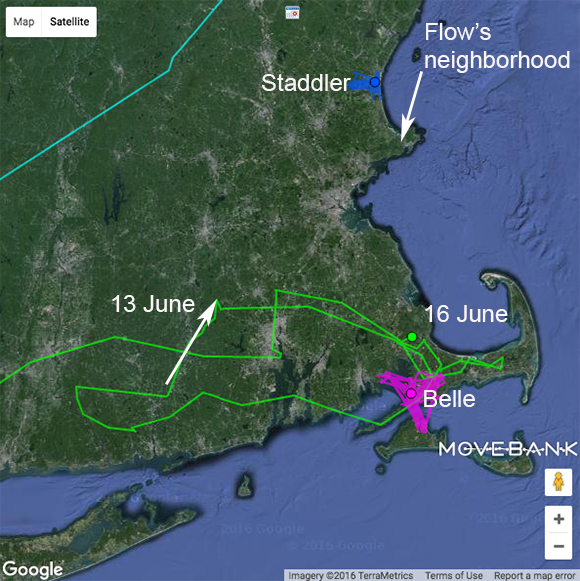 Flow got to central Connecticut on the 7th of June and then spent some time on Cape Cod. He circled back to Connecticut via the Elizabeth Islands on 10th. On the 13th it looked like he was lined up to make a trip to his home town in Essex Co., MA. But then he changed his mind and went back to the western Cape. His theme song has to be Ginger Baker from Blind Faith singing "I can't find my way home"! He's been to some of the ponds that Belle (the pink track) has been visiting for years. I wonder if they've bumped into each other and recounted the stories of the day they landed on their nests hoping to eat a fish and wound up with a transmitter instead.
Flow got to central Connecticut on the 7th of June and then spent some time on Cape Cod. He circled back to Connecticut via the Elizabeth Islands on 10th. On the 13th it looked like he was lined up to make a trip to his home town in Essex Co., MA. But then he changed his mind and went back to the western Cape. His theme song has to be Ginger Baker from Blind Faith singing "I can't find my way home"! He's been to some of the ponds that Belle (the pink track) has been visiting for years. I wonder if they've bumped into each other and recounted the stories of the day they landed on their nests hoping to eat a fish and wound up with a transmitter instead.
Down on the Chesapeake, Holly and Hackett did not have eggs on a recent check and probably will not, but they're definitely committed to the nest. Maybe next year.
Further south, in the Virginian portion of Chesapeake Bay, we've sent some spies over to Tangier Island to see what's up with Nick. Field reports were inconclusive. He's definitely spending a lot of time at a platform close to the one he was nesting on in 2013 when we tagged him, but we don't know if he has a family or not.
In New Hampshire, things look good for Staddler down on the coast in Hampton Beach, just based on how much time he's spending at his nest, but on a recent visit Iain MacLeod made to Wausau's nest, Wausau seemed to be tending to the nest alone. We're worried about the female.
Still no nest for Belle, but (s)he has visited Sengekontacket Pond and the Felix Neck Sanctuary over on Martha's Vineyard 10 times. Nice real estate move if it works out!
26 June
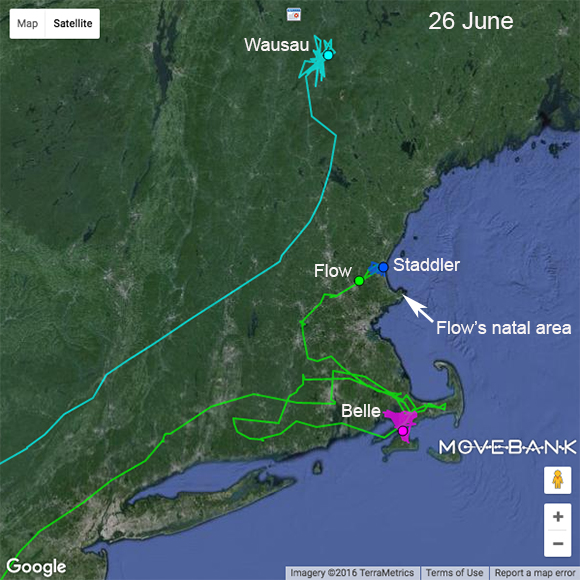 Flow left his winter (and summer and winter) retreat in Cuba on 27 April, which is not unexpected in a juvenile on its first trip north.
On 22 June, he wandered into the home range of our adult male Staddler up in the Seabrook/Hampton Beach marshes. This was after he visited Belle's stomping grounds in the southwestern corner of Cape Cod. Belle continues to visit Martha's Vineyard his/her birthplace and is now commuting across Buzzards Bay to Marion and Mattapoisett in southeastern coastal MA. This is just what Belle has been doing for 5 years. Still no sign of bonding to a site. Over on Nantucket, Snowy, no longer broadcasting due to a broken antenna, lost the eggs or young that seemed to have been in the nest, based on his brooding, photographed by Trish Pastuszak. Now he's hanging around, so he's claimed the turf and should be in good shape. Too bad we won't know whether he'll spend his winter in Cuba or Venezuela. He is the only Osprey that's ever been tagged to have two wildly different winter locations.
Flow left his winter (and summer and winter) retreat in Cuba on 27 April, which is not unexpected in a juvenile on its first trip north.
On 22 June, he wandered into the home range of our adult male Staddler up in the Seabrook/Hampton Beach marshes. This was after he visited Belle's stomping grounds in the southwestern corner of Cape Cod. Belle continues to visit Martha's Vineyard his/her birthplace and is now commuting across Buzzards Bay to Marion and Mattapoisett in southeastern coastal MA. This is just what Belle has been doing for 5 years. Still no sign of bonding to a site. Over on Nantucket, Snowy, no longer broadcasting due to a broken antenna, lost the eggs or young that seemed to have been in the nest, based on his brooding, photographed by Trish Pastuszak. Now he's hanging around, so he's claimed the turf and should be in good shape. Too bad we won't know whether he'll spend his winter in Cuba or Venezuela. He is the only Osprey that's ever been tagged to have two wildly different winter locations.
15 August
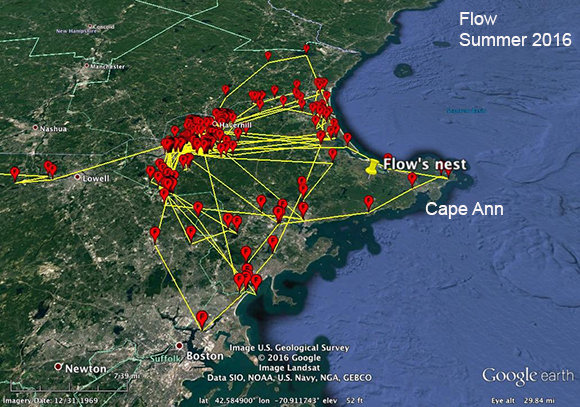 It has been a typically slow summer, which is the way we like it. Flow, on his first summer back in North America, has been concentrating his fishing along the Merrimack River in northeastern Massachusetts. He made a road trip out to Cape Ann on August 2nd. At one point in the the trip, he was about 2 miles from his nest, but that was it. There's been no sign of any interest in returning to his natal marsh. This has been the pattern we've seen with juveniles returning on their first trip north. Belle is behaving just as (s)he has in previous years. She's based at Cape Cod's Long Pond in Falmouth. Early in the summer she commutes a lot to Martha's Vineyard. Later in the summer she visits Marion and Mattapoisett on the western side of Buzzards Bay. Maybe next year Belle will find a mate. We hope her radio keeps working. She's had it for 6 years, and it was out on another bird before Belle got it, so we sort of feel like we're on borrowed time with it. Snowy, tagged a year after Belle in 2011, is no longer on the map--the antenna on his radio broke late in the spring--but we've had recent photos of him on his nest on Nantucket. Next year we'll get over there and try to trap him to get the radio off his back. Wausau's nest failed up in northern New Hampshire. The female seems to have disappeared. In southern New Hampshire, Staddler had 2 healthy young in his nest when Iain MacLeod and I visited the Hampton Beach marshes on July 15th.
It has been a typically slow summer, which is the way we like it. Flow, on his first summer back in North America, has been concentrating his fishing along the Merrimack River in northeastern Massachusetts. He made a road trip out to Cape Ann on August 2nd. At one point in the the trip, he was about 2 miles from his nest, but that was it. There's been no sign of any interest in returning to his natal marsh. This has been the pattern we've seen with juveniles returning on their first trip north. Belle is behaving just as (s)he has in previous years. She's based at Cape Cod's Long Pond in Falmouth. Early in the summer she commutes a lot to Martha's Vineyard. Later in the summer she visits Marion and Mattapoisett on the western side of Buzzards Bay. Maybe next year Belle will find a mate. We hope her radio keeps working. She's had it for 6 years, and it was out on another bird before Belle got it, so we sort of feel like we're on borrowed time with it. Snowy, tagged a year after Belle in 2011, is no longer on the map--the antenna on his radio broke late in the spring--but we've had recent photos of him on his nest on Nantucket. Next year we'll get over there and try to trap him to get the radio off his back. Wausau's nest failed up in northern New Hampshire. The female seems to have disappeared. In southern New Hampshire, Staddler had 2 healthy young in his nest when Iain MacLeod and I visited the Hampton Beach marshes on July 15th.
29 August
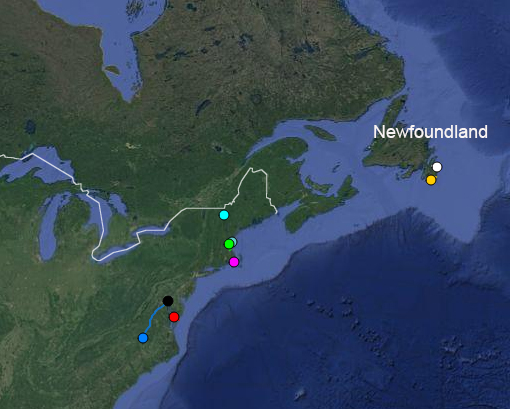 It is so exciting to see those new dots out on Newfoundland! They are the result of a week's work with Newfoundland's principal Osprey fanatic and master organizer, Gerard Hickey, and great support crews from Newfoundland Power, the Memorial University of Newfoundland's Botanical Garden staff, and the volunteer fire department in Trepassey--the yellow dot on the map. That's probably the southernmost Osprey nest on Newfoundland.
It is so exciting to see those new dots out on Newfoundland! They are the result of a week's work with Newfoundland's principal Osprey fanatic and master organizer, Gerard Hickey, and great support crews from Newfoundland Power, the Memorial University of Newfoundland's Botanical Garden staff, and the volunteer fire department in Trepassey--the yellow dot on the map. That's probably the southernmost Osprey nest on Newfoundland.
I arrived on August 21st and did a 2-day Fall Prevention training course so I'd be cleared to go up in NP's bucket truck. On the 24th, my certification card in hand, we headed out to an Osprey nest at NP's Virginia Waters relay station, where a pair of Ospreys has been nesting for some years. The pair fledged three young a week or so before. We set up at 8:35 and within 50 minutes caught the adult female. We named her "Shanawdithit" after the last surviving member of the Beothuk First Nation, the original human inhabitants of what we now call Newfoundland.
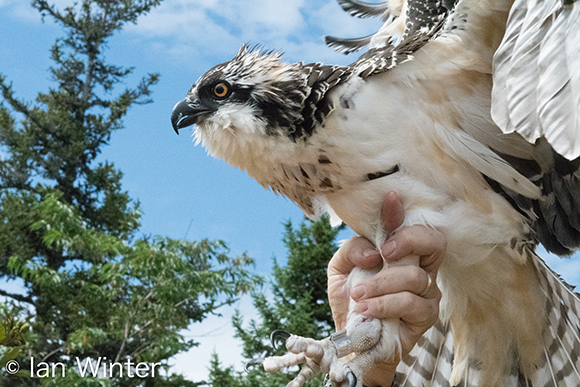 As we were finishing the stitching on Shana's transmitter harness, Shana's mate and one of her daughters landed on the trap and were captured. We banded the adult male and released him. We named the young female "Virginia" after the nearby Virginia Lake, where her parents fish and where she will be learning to fish herself. An hour after we released Virginia, we trapped her sister. This was my 100th Osprey tagged. This feisty bird (pictured here) was named "Jocelyn" after Jocelyn Perry, Newfoundland Power's COO/CFO, in recognition of NP's assistance with the project. By 12:20 Jocelyn was released and we wrapped up a fantastic day in the field.
As we were finishing the stitching on Shana's transmitter harness, Shana's mate and one of her daughters landed on the trap and were captured. We banded the adult male and released him. We named the young female "Virginia" after the nearby Virginia Lake, where her parents fish and where she will be learning to fish herself. An hour after we released Virginia, we trapped her sister. This was my 100th Osprey tagged. This feisty bird (pictured here) was named "Jocelyn" after Jocelyn Perry, Newfoundland Power's COO/CFO, in recognition of NP's assistance with the project. By 12:20 Jocelyn was released and we wrapped up a fantastic day in the field.
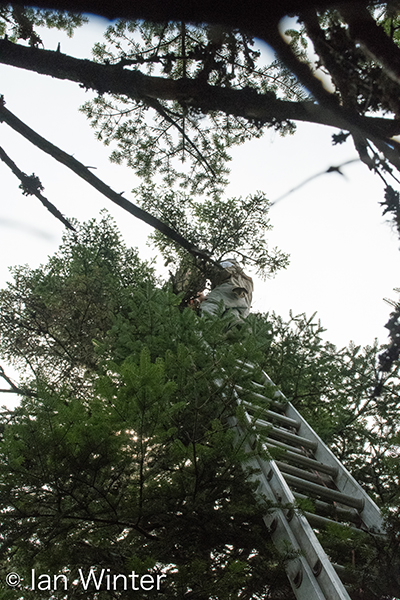 On the 25th we headed over to the Botanical Garden to trap at a nest that Alvan Buckley had located for us. Gerard and I had confirmed that three young had fledged at the nest. This was the trickiest trap setup I've had in 17 years of this research. The nest is atop a 30' spruce in the middle of a very dense forest. Just getting the ladder up through all the lower branches was hard enough, but when I got to the nest, there were too many branches on the far side of the nest to get my tie-down strings over the back side of the nest to secure the trap. It took about 15 minutes, but I finally figured out a way to solve the problem and got 3 of the 4 corners secured with the trap over a nice brown trout. (In the nest were remnants of a fiery orange koi that the male had snatched out of someone's garden pond nearby.)
On the 25th we headed over to the Botanical Garden to trap at a nest that Alvan Buckley had located for us. Gerard and I had confirmed that three young had fledged at the nest. This was the trickiest trap setup I've had in 17 years of this research. The nest is atop a 30' spruce in the middle of a very dense forest. Just getting the ladder up through all the lower branches was hard enough, but when I got to the nest, there were too many branches on the far side of the nest to get my tie-down strings over the back side of the nest to secure the trap. It took about 15 minutes, but I finally figured out a way to solve the problem and got 3 of the 4 corners secured with the trap over a nice brown trout. (In the nest were remnants of a fiery orange koi that the male had snatched out of someone's garden pond nearby.)
We backed off down a power-line clearcut, delayed a few minutes as we picked our way through an awesome blueberry patch, and sat down to watch. 25 minutes later an adult female came in to the nest low and fast, tried to grab the fish and take off. She was clearly a passing bird looking to snatch a free meal. She was caught instantly and did a beak plant on the far side of the nest when the nooses put the brakes on her. The adult pair immediately began strafing her. We got her out quickly and sat waiting to see what would happen next. Our goal was to tag 2 juveniles at this nest, but we'd settle for 1 adult and 1 juvenile if that was what we could get. Deep beneath the dense evergreen canopy we could hear, but not see what sounded like two young begging near the nest 40' above us. They moved off, spooked perhaps by the trap itself or the tip of the ladder, which we'd left propped on the tree below the edge of the nest. After 20 minutes or so, I decided to go ahead and tag "Daphne"--a genus of plants and thus an appropriate name for a female trapped at a botanical garden.
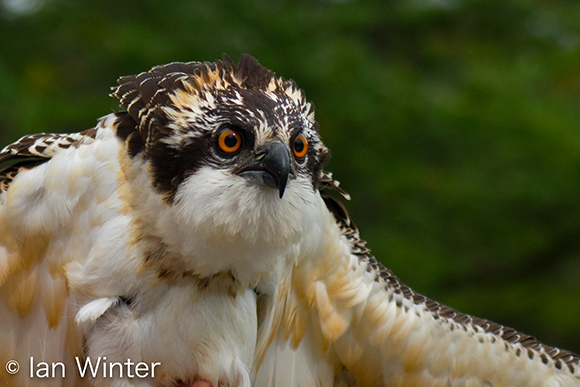 Then we moved into to the waiting game, telling the usual stories, spending some more quality time in blueberry and raspberry patches, and then inevitably and fruitlessly second guessing what was going on in the minds of the Ospreys we were trying to catch. About two hours later the female landed near the nest and one of her offspring began circling over the nest. The first passes were high and very tentative. The young bird hovered over the nest and then swung away, clearly nervous about the different look to the nest. After maybe four passes over the nest--each lower than the last--the bird landed and was quickly caught. It's fun to anthropomorphize and imagine him saying to himself, "I KNEW I shouldn't have landed."
Then we moved into to the waiting game, telling the usual stories, spending some more quality time in blueberry and raspberry patches, and then inevitably and fruitlessly second guessing what was going on in the minds of the Ospreys we were trying to catch. About two hours later the female landed near the nest and one of her offspring began circling over the nest. The first passes were high and very tentative. The young bird hovered over the nest and then swung away, clearly nervous about the different look to the nest. After maybe four passes over the nest--each lower than the last--the bird landed and was quickly caught. It's fun to anthropomorphize and imagine him saying to himself, "I KNEW I shouldn't have landed."
It turned out to be a male, whom we named Leif Erikson (pictured above), recognizing the first "European" (non-resident?) to have landed on Newfoundland and my 50% Norwegian ancestry. He's a beautiful bird. I was glad to have a male to tag--after so many females we were running out of candidate names.
That night we drove down the coast and spent the night about half way to our next trapping destination in the charming village of Renews.
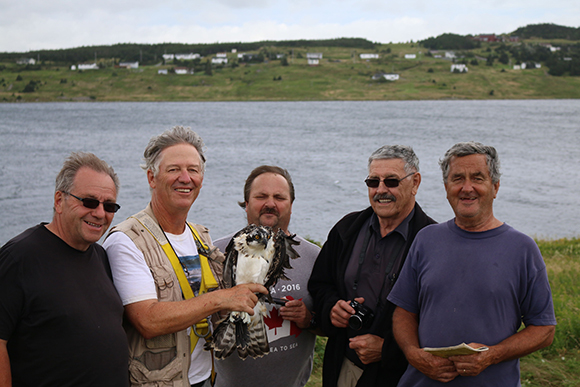 With five Ospreys tagged, we headed out to a nest in Trepassey with one more transmitter to deploy. Trepassey is at the southern tip of the Avalon Peninsula, deep in the heart of "West Ireland," which is what the area should be called. The Irish brogues are so thick I often got confused about which side of the Atlantic I was on. We met up with four members of Trepassey's volunteer fire department (pictured at right, from left to right: Chief Terry Waddleton, me, "Trepassey," Tony Cave, Con Finlay, and Kenneth Hartery), who were waiting for us with the 40' ladder we would need to get to the nest. There was only one young at the nest, so that suggested we might be in for a long day. It's always faster when there are two or three hungry young waiting for food. Indeed, as we arrived, the male showed up with a fish and the young headed off to get a meal. So we knew we were in for a bit of a wait while the young ate that fish and got hungry again.
With five Ospreys tagged, we headed out to a nest in Trepassey with one more transmitter to deploy. Trepassey is at the southern tip of the Avalon Peninsula, deep in the heart of "West Ireland," which is what the area should be called. The Irish brogues are so thick I often got confused about which side of the Atlantic I was on. We met up with four members of Trepassey's volunteer fire department (pictured at right, from left to right: Chief Terry Waddleton, me, "Trepassey," Tony Cave, Con Finlay, and Kenneth Hartery), who were waiting for us with the 40' ladder we would need to get to the nest. There was only one young at the nest, so that suggested we might be in for a long day. It's always faster when there are two or three hungry young waiting for food. Indeed, as we arrived, the male showed up with a fish and the young headed off to get a meal. So we knew we were in for a bit of a wait while the young ate that fish and got hungry again.
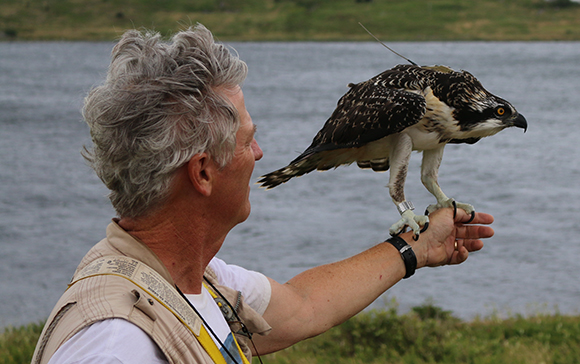 The set-up was as scary as they get. We needed all 40' of the ladder and the wind was blowing about 40 knots. The whole crew was holding onto the ladder to keep it and me from being blown into Trepassey Harbor. Four and a half hours later, about 20 minutes after I decided that we weren't going to catch our bird, one of the adults landed on the nest. I was down on the beach looking up at the nest from afar. I could hear the young begging for food, so I was pretty sure it would follow its parent to the nest. Sure enough, when I got back up off the beach and around to our access point for the nest, both the adult and young were trapped. My Trepassey buddies mustered under the pole and got the ladder up. This time I had a safety harness and hooked into the pole when I got to nest level--the wind was still howling. I cut the nooses on the adult's toes and just let it go and then settled down to getting the youngster out of the nest. Another female! This one we named Trepassey. The harness fitting went smoothly and the flight across Trepassey Harbor with her new transmitter was strong and confident.
The set-up was as scary as they get. We needed all 40' of the ladder and the wind was blowing about 40 knots. The whole crew was holding onto the ladder to keep it and me from being blown into Trepassey Harbor. Four and a half hours later, about 20 minutes after I decided that we weren't going to catch our bird, one of the adults landed on the nest. I was down on the beach looking up at the nest from afar. I could hear the young begging for food, so I was pretty sure it would follow its parent to the nest. Sure enough, when I got back up off the beach and around to our access point for the nest, both the adult and young were trapped. My Trepassey buddies mustered under the pole and got the ladder up. This time I had a safety harness and hooked into the pole when I got to nest level--the wind was still howling. I cut the nooses on the adult's toes and just let it go and then settled down to getting the youngster out of the nest. Another female! This one we named Trepassey. The harness fitting went smoothly and the flight across Trepassey Harbor with her new transmitter was strong and confident.
After we released Trepassey we found ourselves in another amazing blueberry patch as we walked back to the cars. I must admit fresh, wild blueberries with a bit of "eau d'Osprey" on your hands is an acquired taste, but it's one I've come to enjoy.
2 September
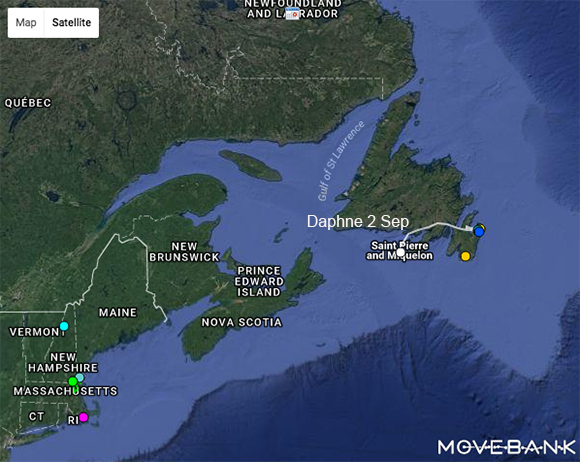 Our first Newfoundland Osprey, Daphne, has taken off and landed, believe it or not, in France. (Scroll down for details of the Newfoundland expedition.) There are two little islands just south of Newfoundland that are, belive it or not, part of France. Daphne is an adult which we trapped at the Memorial University of Newfoundland's Botanical Garden on 25 August. She was a passing bird who saw the fish under our trap and decided to sneak a meal out from under the beaks of the resident adults at the nest we were trapping. Instead of a fish, she got a transmitter. She may have been a breeder whose nest failed, or a young bird that still hasn't found a mate. In any case she's leading the pack out of the Avalon Peninsula. Shana should be next. Down below the border in the States, our newly tagged adult male Hackett is in the Everglades and about to go into the cell-tower dead zone of Cuba. His mate, Holly, seems to be hunkered down in Georgia, waiting out the first hurricane of the season.
Our first Newfoundland Osprey, Daphne, has taken off and landed, believe it or not, in France. (Scroll down for details of the Newfoundland expedition.) There are two little islands just south of Newfoundland that are, belive it or not, part of France. Daphne is an adult which we trapped at the Memorial University of Newfoundland's Botanical Garden on 25 August. She was a passing bird who saw the fish under our trap and decided to sneak a meal out from under the beaks of the resident adults at the nest we were trapping. Instead of a fish, she got a transmitter. She may have been a breeder whose nest failed, or a young bird that still hasn't found a mate. In any case she's leading the pack out of the Avalon Peninsula. Shana should be next. Down below the border in the States, our newly tagged adult male Hackett is in the Everglades and about to go into the cell-tower dead zone of Cuba. His mate, Holly, seems to be hunkered down in Georgia, waiting out the first hurricane of the season.
8 September
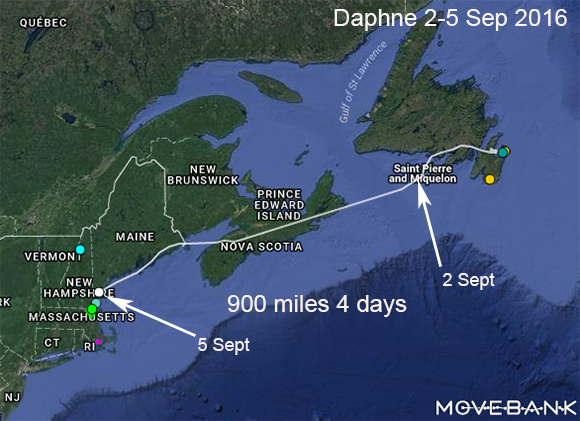 The floodgates have opened--Osprey migration is in full swing. Females have been migrating for a couple of weeks and now the adult males and juveniles are heading south. The Cape May hawkwatch reported over 200 Ospreys yesterday. Daphne, our adult female from St. John's, Newfoundland, must have had some good tailwinds, as she made over 900 miles (about 1,400 km) in four days. Our two adult males from New Hampshire have both bolted for points south as well. Wausau left his nest in northern NH on the 4th and Staddler, who raised two young this year on the Hampton Beach marshes, left on the 5th. As of the 7th, they were both in Virginia. My guess is that Daphne is there with them. The youngsters on Newfoundland's Avalon Peninsula are exploring more and more. I suspect they'll head south sometime late in the month.
The floodgates have opened--Osprey migration is in full swing. Females have been migrating for a couple of weeks and now the adult males and juveniles are heading south. The Cape May hawkwatch reported over 200 Ospreys yesterday. Daphne, our adult female from St. John's, Newfoundland, must have had some good tailwinds, as she made over 900 miles (about 1,400 km) in four days. Our two adult males from New Hampshire have both bolted for points south as well. Wausau left his nest in northern NH on the 4th and Staddler, who raised two young this year on the Hampton Beach marshes, left on the 5th. As of the 7th, they were both in Virginia. My guess is that Daphne is there with them. The youngsters on Newfoundland's Avalon Peninsula are exploring more and more. I suspect they'll head south sometime late in the month.
16 September
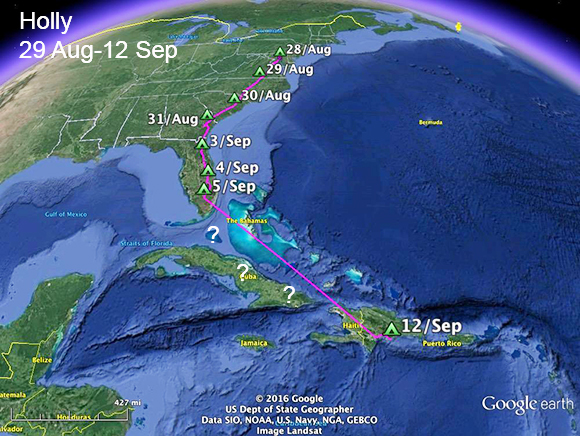 The fall rush is on! Our two Annapolis birds, Holly and Hackett, were the first out of the gates. Hackett left on the 27th and Holly on the 29th (they forgot that the females are supposed to go first!). This was the 1st or 2nd time they've tried to breed. It appeared that Holly had laid eggs, based on her 24/7 attendance at the nest late in the spring, but then she stopped spending nights on the nest and a check confirmed that no eggs were present. The two birds are wearing cell-tower transmitters, which explains the break in their data after they got to southern Florida. We can't get data from them while they're in Cuba, so we have to hope they make it past Cuba to find out what they did there. Holly checked in from the Domincan Republic on 12 Sep. She wasn't near a cell tower for long enough to download all her data (almost 21,000 locations since we tagged her back in May) so we have a gap in her track. This explains the straight line from southern Florida to Hispaniola--she did NOT follow that path--and reminds us that we need to take care in interpreting these maps. At this point (16 Sep) she's probably heading across the Caribbean. Now we hope she'll find a tower down in South America so we can follow the rest of her story. We haven't heard from Hackett for weeks. There's a decent chance that he's wintering in Cuba, which would mean we'll have to wait until he heads north in the spring to discover what he did during the winter. Alternatively, he could pop up anywhere south of Cuba in the next few weeks.
The fall rush is on! Our two Annapolis birds, Holly and Hackett, were the first out of the gates. Hackett left on the 27th and Holly on the 29th (they forgot that the females are supposed to go first!). This was the 1st or 2nd time they've tried to breed. It appeared that Holly had laid eggs, based on her 24/7 attendance at the nest late in the spring, but then she stopped spending nights on the nest and a check confirmed that no eggs were present. The two birds are wearing cell-tower transmitters, which explains the break in their data after they got to southern Florida. We can't get data from them while they're in Cuba, so we have to hope they make it past Cuba to find out what they did there. Holly checked in from the Domincan Republic on 12 Sep. She wasn't near a cell tower for long enough to download all her data (almost 21,000 locations since we tagged her back in May) so we have a gap in her track. This explains the straight line from southern Florida to Hispaniola--she did NOT follow that path--and reminds us that we need to take care in interpreting these maps. At this point (16 Sep) she's probably heading across the Caribbean. Now we hope she'll find a tower down in South America so we can follow the rest of her story. We haven't heard from Hackett for weeks. There's a decent chance that he's wintering in Cuba, which would mean we'll have to wait until he heads north in the spring to discover what he did during the winter. Alternatively, he could pop up anywhere south of Cuba in the next few weeks.
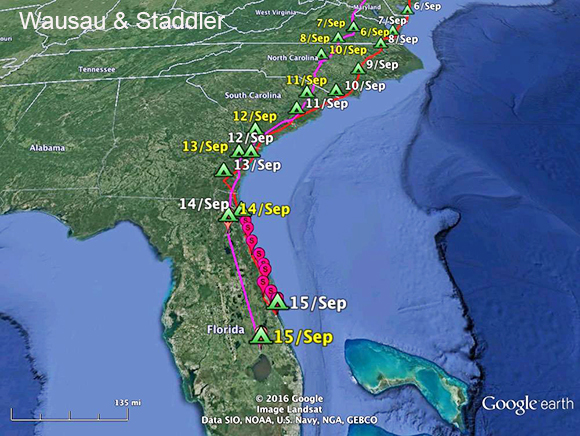 Our boys from New Hampshire, Wausau and Staddler got the migration memo pretty much on the same time. Wausau, after an unsuccessful breeding season (his mate seems to have disappeared) left his nest in northern New Hampshire on 4 Sep. Staddler, who along with his mate fledged 2 young this season, left the marshes of Hampton Beach on the 5th. Staddler took the coastal route and was probably our second bird to be counted at the Cape May Hawkwatch. Wausau kept inland and rode the updrafts along the Kittatiny Ridge right over the Hawk Mountain count. Our birds are showing off this year, visiting two of the most famous eastern hawkwatch sites. Both are now down in southern Florida (Wausau is the pink line, with yellow labels to his roost locations). Their paths have become quite synchronous.
Our boys from New Hampshire, Wausau and Staddler got the migration memo pretty much on the same time. Wausau, after an unsuccessful breeding season (his mate seems to have disappeared) left his nest in northern New Hampshire on 4 Sep. Staddler, who along with his mate fledged 2 young this season, left the marshes of Hampton Beach on the 5th. Staddler took the coastal route and was probably our second bird to be counted at the Cape May Hawkwatch. Wausau kept inland and rode the updrafts along the Kittatiny Ridge right over the Hawk Mountain count. Our birds are showing off this year, visiting two of the most famous eastern hawkwatch sites. Both are now down in southern Florida (Wausau is the pink line, with yellow labels to his roost locations). Their paths have become quite synchronous.
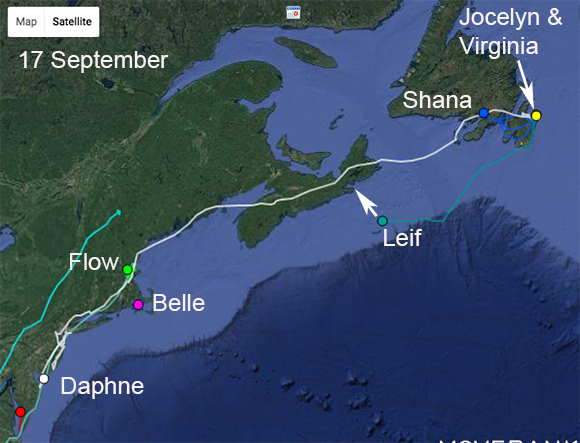 Up in Newfoundland, our adult female Daphne took off on 2 Sep and made it to Cape May, NJ, where she was photographed carrying a fish over the hawkwatch platform (details in the update below). Leif, a young male tagged at the MUN Botanical Garden, was the first young to leave. He was photographed by Clifford Doran at Cape Race. He took off over the Atlantic around 7AM on the 16th. The latest satellite data (not currently showing up on the interactive map) shows that he headed north and is now safely on Nova Scotia. I was a bit surprised to see him head due west. I suspect he may have been high enough to see Nova Scotia and turned north to make for land. Shana (adult female, mother of Virginia and Jocelyn) made an aborted start to her migration on 11 Sep. She went back home and then started again on the 16th. I suspect this will be the real move.
Up in Newfoundland, our adult female Daphne took off on 2 Sep and made it to Cape May, NJ, where she was photographed carrying a fish over the hawkwatch platform (details in the update below). Leif, a young male tagged at the MUN Botanical Garden, was the first young to leave. He was photographed by Clifford Doran at Cape Race. He took off over the Atlantic around 7AM on the 16th. The latest satellite data (not currently showing up on the interactive map) shows that he headed north and is now safely on Nova Scotia. I was a bit surprised to see him head due west. I suspect he may have been high enough to see Nova Scotia and turned north to make for land. Shana (adult female, mother of Virginia and Jocelyn) made an aborted start to her migration on 11 Sep. She went back home and then started again on the 16th. I suspect this will be the real move.
26 September
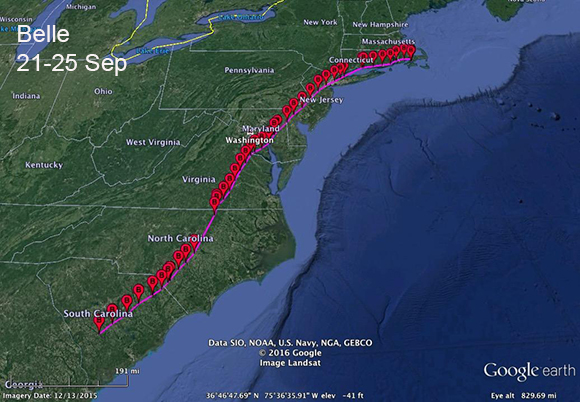 Eight of our 12 birds wearing transmitters are heading south. Two (Holly and Hackett from Annapolis) are in cell-tower limbo. Holly checked in from the D.R. on 12 Sep, then went dark. We last heard from Hackett in southern Florida on 3 Sep. This is the first time these birds have migrated with transmitters, so we don't know where they winter. Hackett may well be in Cuba. If so, we won't hear from him until he comes home in the spring because we don't have a contract with Cuban cell-tower companies to get the data. We hope Holly is somewhere in South America now out of range of cell towers. Our two New Hampshire males (Wausau and Staddler) are both in the center lane of the Osprey "Highway to the Tropics" in southeastern Cuba. Belle is off on his/her 6th migration south (a record for our birds). She's in South Carolina as of the 15th, 5 days and about 840 miles into her trip to southern Brazil. Only Nick (Tangier Island in Chesapeake Bay) and Flow (2-yr old in Essex, MA) are still packing their bags.
Eight of our 12 birds wearing transmitters are heading south. Two (Holly and Hackett from Annapolis) are in cell-tower limbo. Holly checked in from the D.R. on 12 Sep, then went dark. We last heard from Hackett in southern Florida on 3 Sep. This is the first time these birds have migrated with transmitters, so we don't know where they winter. Hackett may well be in Cuba. If so, we won't hear from him until he comes home in the spring because we don't have a contract with Cuban cell-tower companies to get the data. We hope Holly is somewhere in South America now out of range of cell towers. Our two New Hampshire males (Wausau and Staddler) are both in the center lane of the Osprey "Highway to the Tropics" in southeastern Cuba. Belle is off on his/her 6th migration south (a record for our birds). She's in South Carolina as of the 15th, 5 days and about 840 miles into her trip to southern Brazil. Only Nick (Tangier Island in Chesapeake Bay) and Flow (2-yr old in Essex, MA) are still packing their bags.
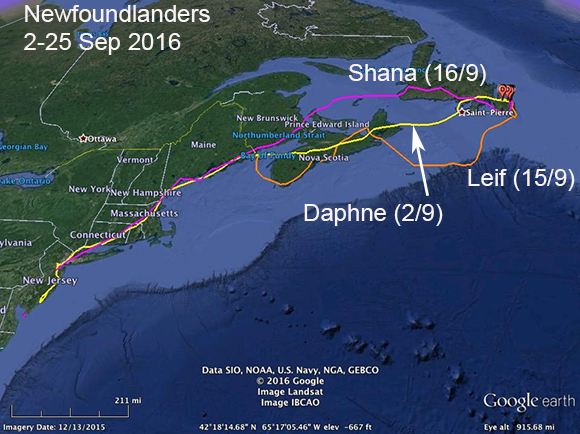 Three of our five surviving Newfounlanders are on the move. Adult female Daphne (yellow track) was the first to go, leaving on 2 Sep. She did what we expect the adults to do, which is to go west to get to the east coast of the U.S. and then head south to Florida, Cuba, and points south. For an amusing bit of geographical trivia, Daphne actually went through France--there are two small islands just south of Newfoundland (St. Pierre and Miquelon) that are part of France--to get to the east coast of the U.S. She's down in Cape May now on a migration hiatus. The next to migrate was Leif Erikson (orange track), a juvenile male trapped at the same nest where we caught Daphne trying to steal fish from a nest that wasn't her own. Leif also started out as we expected--heading due south until he ran out of land and then flying out over the Atlantic. He then surprised us by turning west and then north to get up to Cape Breton Island. He then again flew south until he ran out of land, but once again turned north and found his way across the Bay of Fundy to Maine. Finally, Shawnadithit (pink track), adult female from St. John's, flew due west to continental North America to begin her trip down the coast. She's now in Baltimore, not far from Daphne.
Three of our five surviving Newfounlanders are on the move. Adult female Daphne (yellow track) was the first to go, leaving on 2 Sep. She did what we expect the adults to do, which is to go west to get to the east coast of the U.S. and then head south to Florida, Cuba, and points south. For an amusing bit of geographical trivia, Daphne actually went through France--there are two small islands just south of Newfoundland (St. Pierre and Miquelon) that are part of France--to get to the east coast of the U.S. She's down in Cape May now on a migration hiatus. The next to migrate was Leif Erikson (orange track), a juvenile male trapped at the same nest where we caught Daphne trying to steal fish from a nest that wasn't her own. Leif also started out as we expected--heading due south until he ran out of land and then flying out over the Atlantic. He then surprised us by turning west and then north to get up to Cape Breton Island. He then again flew south until he ran out of land, but once again turned north and found his way across the Bay of Fundy to Maine. Finally, Shawnadithit (pink track), adult female from St. John's, flew due west to continental North America to begin her trip down the coast. She's now in Baltimore, not far from Daphne.
1 October
Our first two birds (Wausau and Staddler from NH) are across the Caribbean safely ahead of Hurricane Matthew. We thought we'd lost the juvenile male Leif from St. John's, but he reappeared after a very weak satellite upload that suggested he was dead. With the departure of Flow from NE Massachusetts on the 28th (probably) and Nick on the 29th, all our birds are on the move, with the exception of Virginia, a young female from St. John's Newfoundland. TEST
5 October
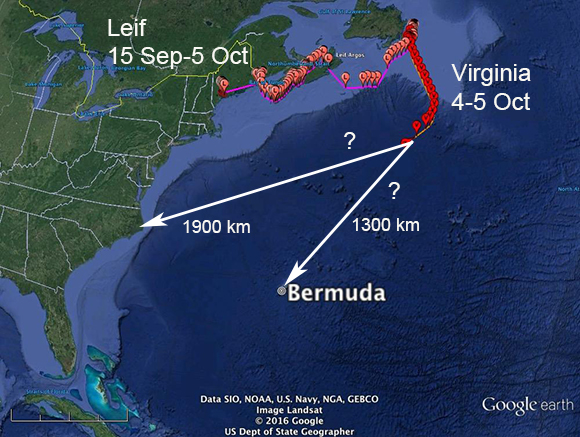 It's on! Virginia, our juvenile female from St. John's, Newfoundland, is out over the Atlantic. Like Leif (a juvenile male also from St. John's), Virginia went south to the tip of the Avalon Peninsula and then, after a bit of fishing at Peters Pond just to top off the tanks, headed south over the Atlantic. This is in stark contrast to what our two adults, Daphne and Shana, did. Having done this migrations thing before, they knew that the safe way to their wintering waters is to go west first and then down the east coast of the U.S. They would have "discovered" that on their first trip north. It is exactly what we had predicted. Virginia made a bit of a trial run before starting her migration for real. On 30 Sept she left her nest and went down to the southern coast. After seeing all that open ocean ahead of her, she visited Peter's Pond and spent the night there before returning to her nest. Maybe she decided she needed a bigger bag! The next day she took off again and this time she meant it. She spent another night at Peter's Pond before leaving Newfoundland behind about 0700h on the morning of the 4th. The first nine hours she flew straight south-southeast and then made a turn to the southwest. This put her on course to hit Bermuda (maybe) or the east coast of the U.S. This is what the whole Project Newfoundland expedition was all about--documenting naive Ospreys making their first trip south without a genetic map for the route to the wintering grounds. Exciting and nerve-wracking times! We now have to wait 3 days to see what happens next.
It's on! Virginia, our juvenile female from St. John's, Newfoundland, is out over the Atlantic. Like Leif (a juvenile male also from St. John's), Virginia went south to the tip of the Avalon Peninsula and then, after a bit of fishing at Peters Pond just to top off the tanks, headed south over the Atlantic. This is in stark contrast to what our two adults, Daphne and Shana, did. Having done this migrations thing before, they knew that the safe way to their wintering waters is to go west first and then down the east coast of the U.S. They would have "discovered" that on their first trip north. It is exactly what we had predicted. Virginia made a bit of a trial run before starting her migration for real. On 30 Sept she left her nest and went down to the southern coast. After seeing all that open ocean ahead of her, she visited Peter's Pond and spent the night there before returning to her nest. Maybe she decided she needed a bigger bag! The next day she took off again and this time she meant it. She spent another night at Peter's Pond before leaving Newfoundland behind about 0700h on the morning of the 4th. The first nine hours she flew straight south-southeast and then made a turn to the southwest. This put her on course to hit Bermuda (maybe) or the east coast of the U.S. This is what the whole Project Newfoundland expedition was all about--documenting naive Ospreys making their first trip south without a genetic map for the route to the wintering grounds. Exciting and nerve-wracking times! We now have to wait 3 days to see what happens next.
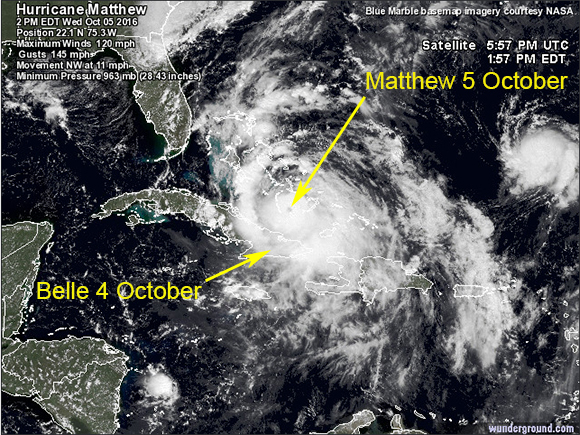 Everyone is concerned about how our birds are going to get along with Hurricane Matthew. Staddler and Wausau, from up in New Hampshire, went south before the storm got to Hispaniola. Belle and Matthew have come together in southeastern Cuba. Belle was there on the 4th as Matthew was approaching from the east. Exactly when they met, we'll only be able to tell when we get the next data from Belle on the 7th. I think she'll be OK as I expect she would have been feeling the front edge of the storm on the 4th and thus she wasn't likely to head out over open water--the real danger for Ospreys, which can't get down on the water and float like a duck or gull. When they're on land, they should be able to get down on the ground and wait out a storm. We'll find out soon! Four other birds are in the projected path of Matthew. Nick, Shana, Flow, and Daphne are all in Florida or soon will be. Virginia is the next bird to worry about, because she's out over the water. As she nears the storm, she'll encounter strong winds from the east which should help her get to the coast ahead of the storm. Or maybe she'll find Bermuda and hunker down there.
Everyone is concerned about how our birds are going to get along with Hurricane Matthew. Staddler and Wausau, from up in New Hampshire, went south before the storm got to Hispaniola. Belle and Matthew have come together in southeastern Cuba. Belle was there on the 4th as Matthew was approaching from the east. Exactly when they met, we'll only be able to tell when we get the next data from Belle on the 7th. I think she'll be OK as I expect she would have been feeling the front edge of the storm on the 4th and thus she wasn't likely to head out over open water--the real danger for Ospreys, which can't get down on the water and float like a duck or gull. When they're on land, they should be able to get down on the ground and wait out a storm. We'll find out soon! Four other birds are in the projected path of Matthew. Nick, Shana, Flow, and Daphne are all in Florida or soon will be. Virginia is the next bird to worry about, because she's out over the water. As she nears the storm, she'll encounter strong winds from the east which should help her get to the coast ahead of the storm. Or maybe she'll find Bermuda and hunker down there.
23 October 2016
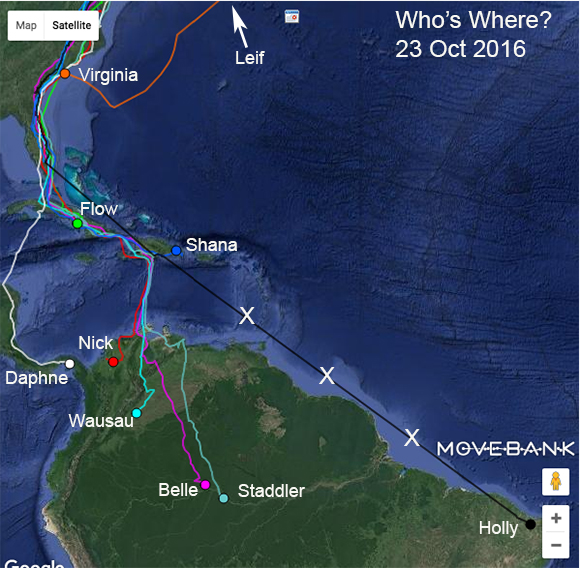 I've fallen behind on updates as a result of some long-distance movements of my own. I spent a week down in Costa Rica at the annual meeting of the Neotropical Raptor Network and then flew north, against the tide of migration, to Cape May, NJ, where the Raptor Research Foundation held our 50th annual meeting. Both sessions were fantastic. While I was out and about, our birds were on the move. While I was in Costa Rica, Daphne and I were 30 miles apart.
I've fallen behind on updates as a result of some long-distance movements of my own. I spent a week down in Costa Rica at the annual meeting of the Neotropical Raptor Network and then flew north, against the tide of migration, to Cape May, NJ, where the Raptor Research Foundation held our 50th annual meeting. Both sessions were fantastic. While I was out and about, our birds were on the move. While I was in Costa Rica, Daphne and I were 30 miles apart.
Five of our birds are safely at their winter headquarters. Flow took only 10 days to get to his Cuban wintering site southwest of Camaguey. Nick got a late start (as usual) from Tangier Island in Chesapeake Bay, and wasted no time (as usual) getting got to the Magdalena Valley in northern Columbia in only 17 days. Our two adult males from New Hampshire took over a month to get to their winter waters. Staddler settled down on Lake Tefe at the south bank of the Amazon River 39 days after he left coastal New Hampshire. Wausau took 32 days to get from northern NH to his spot in central Colombia. Our Annapolis, MD, female Holly seems to be at a likely winter spot in far eastern Brazil. This is the farthest east any tagged Osprey has wintered. Appropriately, she's on the Rio Piranhas! We're missing data from her trip, so the straight line from Hispaniola to Brazil is not the path she took, just a line connecting consecutive data points.
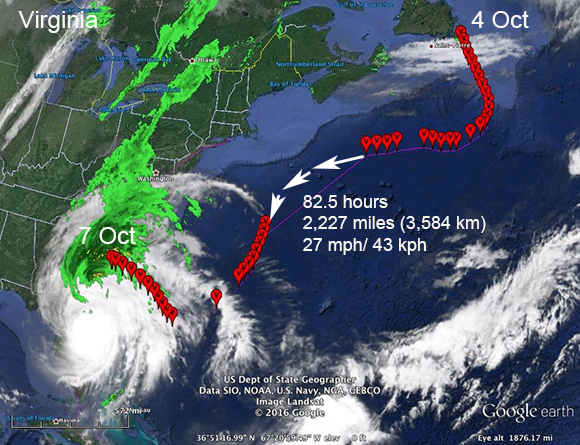 Sadly, we lost Virginia. After about 72 hours on the wing over the Atlantic, she flew into the edge of Hurricane Matthew and was swept northwest to the coast of South Carolina. The whole trip was fascinating and confirmed what we had predicted for juveniles from Newfoundland--that they would head south over the Atlantic. I was surprised when she turned west, but then discovered that she was flying around an oncoming weather front. After she got past the storm she turned south again and was headed for the Bahamas until she flew into the edge of Hurricane Matthew. The winds of the storm blew her northwest to the shore of South Carolina, where the storm then rolled over her. She did not survive, but we're still getting signals from her radio, so we have a chance to get it back and redeploy it on another juvenile next summer.
Sadly, we lost Virginia. After about 72 hours on the wing over the Atlantic, she flew into the edge of Hurricane Matthew and was swept northwest to the coast of South Carolina. The whole trip was fascinating and confirmed what we had predicted for juveniles from Newfoundland--that they would head south over the Atlantic. I was surprised when she turned west, but then discovered that she was flying around an oncoming weather front. After she got past the storm she turned south again and was headed for the Bahamas until she flew into the edge of Hurricane Matthew. The winds of the storm blew her northwest to the shore of South Carolina, where the storm then rolled over her. She did not survive, but we're still getting signals from her radio, so we have a chance to get it back and redeploy it on another juvenile next summer.
Leif, our surviving youngster, also headed over the Atlantic from the southern tip of the Avalon Peninsula. He then turned west and then northwest, finding himself on Nova Scotia. My guess is that weather pushed him that way. He then found the southern tip of Nova Scotia, as we expected, and then, surprisingly, flew northwest and got to the coast of Maine. He has settled down in Lewiston, ME, on the Androscoggin River. He's a teenager, and is easily distracted. He's been in Lewiston for a month now. This is unusual, but not unprecedented. Our Martha's Vineyard juvenile Meadow went all the way west to Lake Superior and settled down there until 15 November. I joked that she finally headed south when she tried to catch a fish and bounced off the ice. That may happen to Leif, as snow is predicted today for northern New England.
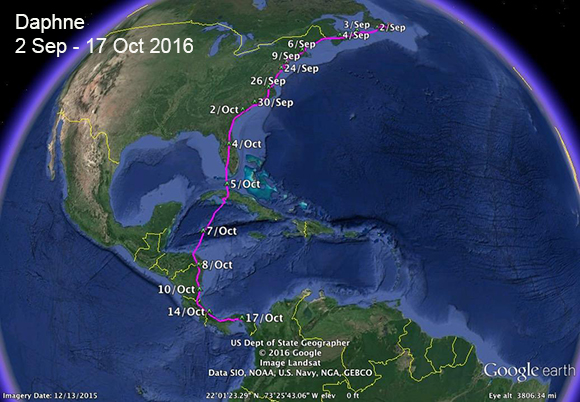 Daphne took a very unusual route to what may be her wintering range on the Pacific slope of Panama. She is only the 3rd satellite-tagged adult Osprey to fly from Cuba to Central America--all the others have flown from Cuba to Hispaniola to South America. My guess is that Daphne made this same trip on her first trip south and has followed the same route on subsequent migrations.
Daphne took a very unusual route to what may be her wintering range on the Pacific slope of Panama. She is only the 3rd satellite-tagged adult Osprey to fly from Cuba to Central America--all the others have flown from Cuba to Hispaniola to South America. My guess is that Daphne made this same trip on her first trip south and has followed the same route on subsequent migrations.
Shana, our other adult female from Newfoundland, is in the Dominican Republic. She's been there since 14 Oct. This is a bad place for an Osprey to be wandering about. There are, sadly, way too many uneducated Dominicans who love to shoot anything they see. The way she's wandering around does not have the feel of a bird on their wintering range--no reservoir or lake and no big river. She's hanging around a pretty arid landscape with small streams. I think she'll move on soon.
Belle is in the middle of the Amazon and probably 3 days away from her winter home on the Madeira River at the southern edge of the Amazonian rainforest. This is her record-setting 6th fall migration with a satellite radio.
That leaves only Hackett unaccounted for. He's a newly tagged adult male wearing a GSM, or cell-tower transmitter. We last heard from him in the Everglades. We have no contract with Cuban cell-tower providers, so we always lose track of our GSM birds after they leave Florida. If they make it to Hispaniola, we usually get some data. This happened with Hackett's mate Holly. There's a pretty good chance Hackett is wintering in Cuba. If that's the case, we won't hear from him again until the spring. Alternatively, he may have made it to somewhere in South America, dodging cell-towers the whole way. This is less likely. We usually get signals from birds when they get to Colombia or Venezuela--but not always. Holly made it across all of northern South America and only found a cell-tower when she was at the eastern edge of Brazil. Finally, it's possible that he died somewhere along the way. He was ahead of most of the hurricane activity, but that doesn't guarantee his safety. There are lots of other mishaps that can befall a migrating Osprey.
8 November 2016
Our last adult, Shana, has finally settled down after making us nervous as she gallavanted around the Dominican Republic, where we have had far too many Ospreys shot. She arrived at what is obviously familar ground to her on 28 Oct., 43 days after leaving her nest area in St. John's, Newfoundland.
Leif continues to hang out in Lewiston, ME, perhaps he's auditing courses at Bates College? He will be the 2nd latest bird to start if he gets going before 15 November, the date the current record holder, Meadow, took off from her staging area on Michigan's Upper Peninsula (she was born more than 1,400 km east on Martha's Vineyard!).
We got Virginia's transmitter back and are now testing it on my back patio--hence the orange spot on the map up near Philadelphia. Once it goes through one more cycle, I'll take it off the air and reactivate it next summer to put on another Newfoundland juvenile.
13 November
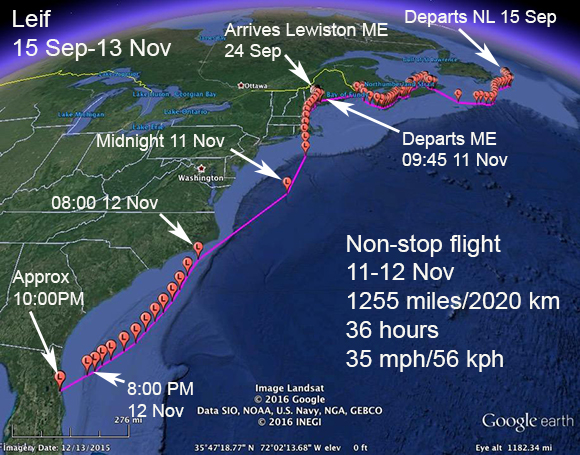 At long last, Newfoundland juvenile Leif has left his temporary 'hood in Lewiston, ME, after a 47-day layover! As we have seen before with many juveniles heading south from New England, Leif got to the coast of southeastern Massachusetts and just kept going south over the Atlantic Ocean, finally making landfall in Daytona Beach 30 hours later.
At long last, Newfoundland juvenile Leif has left his temporary 'hood in Lewiston, ME, after a 47-day layover! As we have seen before with many juveniles heading south from New England, Leif got to the coast of southeastern Massachusetts and just kept going south over the Atlantic Ocean, finally making landfall in Daytona Beach 30 hours later.
The Leif Erikson Saga--so far! Leif left his natal area in St. John's, Newfoundland, on 15 Sep. As we predicted, he just went south until he ran out of land and then kept going out over the Atlantic, as did another Newfoundland juvenile, Virginia. Unlike Virginia, Leif turned west and then northwest and found Cape Breton Island. From there, he worked south to Nova Scotia and once again found the southern tip of the island. Rather than head south, as I expected, he worked northwest and found Maine. He worked his way west and settled down in Lewiston, Maine, where he spent almost a month and a half fishing the Androscoggan River and a couple of near-by lakes. Finally, nicely fattened up and four days short of breaking Meadow's record for the latest migration start by a juvenile Osprey, he flipped the migration switch and took off at about 9:45AM on 11 Nov. He passed over Portland at 11:00 and then through the Boston airspace at 3:30PM. Pushing south, he got to the Westport River at 5PM and kept going south over the Atlantic. By 8:00PM he had flown 302 miles in 10 hours. When he took his next GPS fix at midnight, he had turn a bit southwest and flown another 164 miles, averaging 41 mph, very fast for a migrating Osprey.
The next fix we have was at 8:00 on the morning of the 12th, when he was 20 miles south of North Carolina's Cape Lookout. Based on the trajectory when we pick up his GPS track again, it looks like he might have passed over the Outer Banks, but we know he did not stop and rest. He continued at his 40 mph pace from midnight to 8AM, so there was no time for him to have stopped. He continued to swing southwest and arrived at the heart of Daytona Beach about 10PM, 36 hours after he left Lewiston.
His comparatively leisurely trip from St. John's to Lewiston took 11 days and covered 1,211 miles (1,949 km). After his 47-day stopover, he covered 1,255 miles (2,020 km) in less than two days.
There's no telling what's next. This late in the season, it would not be unexpected if he settled in Florida. But experience tells us that he could still keep going all the way to the Amazon. I will make no predictions. I'll just keep checking for his downloads every 3 days and hope he settles somewhere safe. One bit of good news is that if he does go all the way to South America, he's missed hurricane season.
18 November 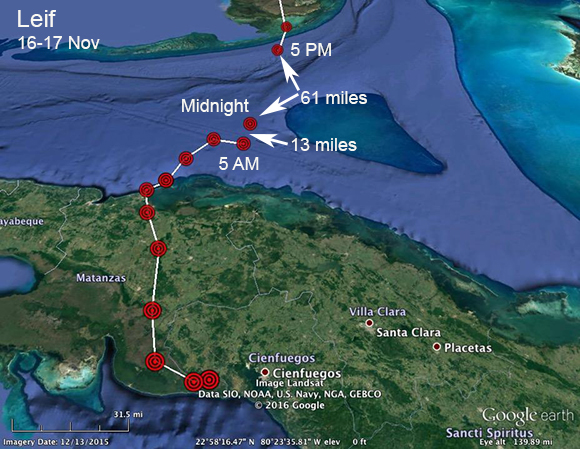
Where was Leif-An Osprey mystery?
Leif got to Daytona Beach on the evening of the 12th. The next morning, perhaps after a bit of fishing, he was on the wing again by 9:30. He flew about 50 miles to the Orlando area, where he spent the 14th, obviously fishing. On the 15th, he moved another 50 miles south, spending the night near Frostproof.
On the 16th he got back into full migration mode, starting south before 10 AM. At 4 PM he was passing over the Florida Keys (Islamorada), Cuba-bound. Our last GPS fix for the afternoon was at 5 PM out over the Florida Straights. The next location is at midnight, 7 hours later, but only 61 miles south of his 5 PM location. So we're missing something, because Leif can't fly under 9 miles an hour, so he had to have stopped. Then we pick him up again at 5 AM, just 13 miles south of the midnight GPS point. So, where was Leif from 5 PM to 5 AM? The most likely explanation is that he spent some time resting on something--probably a boat--but we don't have enough information to say for sure.
2015 begins here (still in reverse chronological order).
14 December
 Once again we have a December surprise. Normally by late October the adults are all settled down in their winter sites--the same ones they've used year after year. So this year, when our Fishers Island, NY, male Charlie did not show up at this winter HQ in northern Colombia, we assumed the worst. He's a cell tower bird, so we expect radio silence through Cuba, but we almost always pick these birds up as they come through Haiti and the D.R. Not a peep from Charlie though all of November, so it looked bad. And then on 13 December, we got an email data dump from him in the D.R. So, it turns out we don't know exactly how he got through the first bit of Cuba, but he left the Keys on 26 September and showed up in central Cuba on 22 Oct. (We may still get the data from the missing part of the trip in future downloads.) He spent 4 nights around 2 small reservoirs before moving to the Jimaguayu Reservoir on the 26th. Here, just 10 km north of the spot where our MA 2014 juvenile Flow has been biding his time, Charlie spent 38 days. Then, for reasons we'll never fathom, on 3 December he flipped on the migration switch again and headed southeast through the rest of Cuba. He made it over to Haiti on the 9th of December. He started south towards Cape Beata, launching pad for most adults crossing the Caribbean, but then turned northeast and is now in a heavily agricultural region in southwestern Dominica. We hope he keeps moving, as the Dominicans have proven rather trigger happy when it comes to our Ospreys. Where he was when we last heard from him is certainly not an Osprey-like habitat, so he was probably just moving over it. Keep watching the map!
Once again we have a December surprise. Normally by late October the adults are all settled down in their winter sites--the same ones they've used year after year. So this year, when our Fishers Island, NY, male Charlie did not show up at this winter HQ in northern Colombia, we assumed the worst. He's a cell tower bird, so we expect radio silence through Cuba, but we almost always pick these birds up as they come through Haiti and the D.R. Not a peep from Charlie though all of November, so it looked bad. And then on 13 December, we got an email data dump from him in the D.R. So, it turns out we don't know exactly how he got through the first bit of Cuba, but he left the Keys on 26 September and showed up in central Cuba on 22 Oct. (We may still get the data from the missing part of the trip in future downloads.) He spent 4 nights around 2 small reservoirs before moving to the Jimaguayu Reservoir on the 26th. Here, just 10 km north of the spot where our MA 2014 juvenile Flow has been biding his time, Charlie spent 38 days. Then, for reasons we'll never fathom, on 3 December he flipped on the migration switch again and headed southeast through the rest of Cuba. He made it over to Haiti on the 9th of December. He started south towards Cape Beata, launching pad for most adults crossing the Caribbean, but then turned northeast and is now in a heavily agricultural region in southwestern Dominica. We hope he keeps moving, as the Dominicans have proven rather trigger happy when it comes to our Ospreys. Where he was when we last heard from him is certainly not an Osprey-like habitat, so he was probably just moving over it. Keep watching the map!
And just when we thought we could relax for the winter and not be worrying about our birds.
19 November
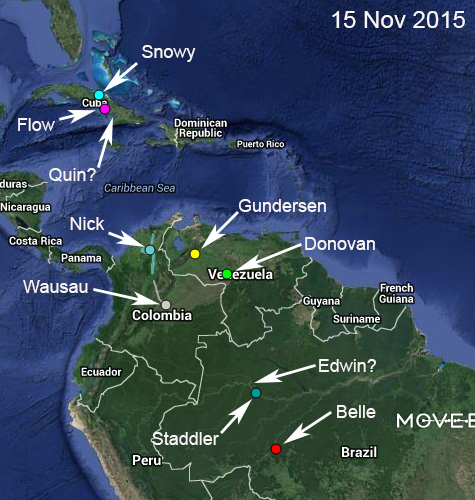 We lost our old friend and Long Island celebrity North-Fork Bob as he was migrating south over Florida. Thanks to Reinier Munguia of the Audubon Center for Birds of Prey, we recovered Bob's transmitter. All that was left of him were his wings out in a cattle pasture. There is a pair of Bald Eagles nearby so he may have had an encounter with an eagle, or he may have been picked off by a Great-horned Owl, which I think is more likely. Reinier reports that as Bald Eagles have become more and more abundant in central Florida, the number of Ospreys that are brought in to the rehab facility at the Audubon Center with broken limbs has been growing. These injuries are probably sustained when a Bald Eagle attempts to steal food from an Osprey. Given that Bob wouldn't have been carrying a fish when we lost him, I think it unlikely that an eagle would have harassed him, and if it had, an Osprey not carrying a fish can usually out maneuver an eagle. It looks like Bob had settled down at the edge of a stand of pines for the evening and was probably picked off by an owl.
We lost our old friend and Long Island celebrity North-Fork Bob as he was migrating south over Florida. Thanks to Reinier Munguia of the Audubon Center for Birds of Prey, we recovered Bob's transmitter. All that was left of him were his wings out in a cattle pasture. There is a pair of Bald Eagles nearby so he may have had an encounter with an eagle, or he may have been picked off by a Great-horned Owl, which I think is more likely. Reinier reports that as Bald Eagles have become more and more abundant in central Florida, the number of Ospreys that are brought in to the rehab facility at the Audubon Center with broken limbs has been growing. These injuries are probably sustained when a Bald Eagle attempts to steal food from an Osprey. Given that Bob wouldn't have been carrying a fish when we lost him, I think it unlikely that an eagle would have harassed him, and if it had, an Osprey not carrying a fish can usually out maneuver an eagle. It looks like Bob had settled down at the edge of a stand of pines for the evening and was probably picked off by an owl.
All our birds are settled down for the winter. Nick (Chesapeake Bay) is wandering around the Magdalena River valley much more than a typical adult. Usually, adults return to the same spot and move very little over their five month winter vacation. Of the three other cell-tower birds, Quin (Chesapeake Bay) and Edwin (Long Island Sound) are probably safe in their cell-tower-free winter ranges (Cuba and Amazonia, respectively), but I suspect we lost Charlie (Fishers Island) somewhere between Florida and Colombia. As I remember, he wintered in an area with cell-tower coverage, so his lack of signals suggests the worst.
New Hampshire male Donovan has missed two uploads, so he's either dead or his radio has failed. As a rule, when a transmitter just stops from one upload to the next, the bird is dead. We've never had a bird show up at a nest with a dead transmitter after a sudden loss of signal. We have had two radios die and seen the birds later (Jaws and Sr. Bones), but in both cases the radios sputtered--coming on and off--before we finally lost signal. Donovan's radio is in its 4th year, so that gives us some hope--it's the same time frame that we lost the signal from Sr. Bones. We'll have to wait for spring to see if Donovan shows up at his nest in Tilton, NH. Keep your talons crossed.
All the other birds seem to be doing fine. Flow (northeastern MA) will be coming home for the first time in about five months.
20 October
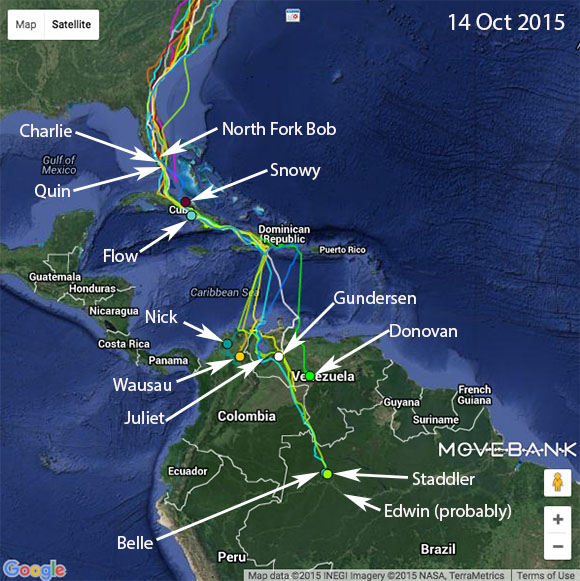 Nick (a Tangiers Island male) got back to his winter area in the Magdalena River valley. He arrived on 29 Sept, just 12 days after leaving the Chesapeake Bay. He is exhibiting some unusual behavior. He arrived at his wintering area in the Magdalena valley and has made two rather substantial "road trips" wandering away from his regular spot. Most adults get back to their winter HQ and stay put for the duration.
Nick (a Tangiers Island male) got back to his winter area in the Magdalena River valley. He arrived on 29 Sept, just 12 days after leaving the Chesapeake Bay. He is exhibiting some unusual behavior. He arrived at his wintering area in the Magdalena valley and has made two rather substantial "road trips" wandering away from his regular spot. Most adults get back to their winter HQ and stay put for the duration.
Quin, our second male from Tangiers Island, was last heard from on the 8th, crossing Key Largo--just 2 miles from the hotel I was staying in at the time. He won't have made it to the Caribbean yet, but is somewhere in Cuba.
See the New England Fall page for updates on the rest of the flock.
28 September 2015:
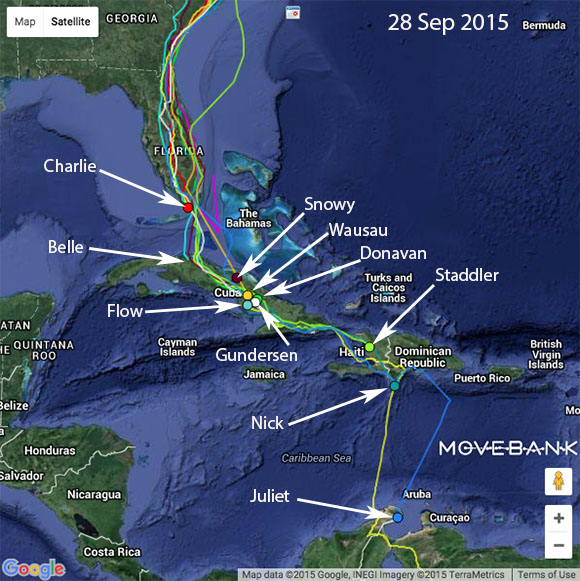 One of our two surviving Chesapeake birds, Nick crossed the Caribbean and is almost back at his winter home in the Magdalena River Valley in Colombia. Quin is still on Tangier Island. Last year he left on 26 Sept. so as of this update, he's two days behind schedule.
One of our two surviving Chesapeake birds, Nick crossed the Caribbean and is almost back at his winter home in the Magdalena River Valley in Colombia. Quin is still on Tangier Island. Last year he left on 26 Sept. so as of this update, he's two days behind schedule.
As for the New England flock, we've lost Artoo between Florida and Cuba. The pink track going north was probably him on a boat going north, and then at the end, apparently his body floating in the Florida Current. We have no idea what might have happened to him. There's no indication that there was any severe weather in the area, so this is a complete, and very frustrating mystery. We're not supposed to get attached to our study subjects, but we do. It's especially frustrating when a young bird makes it through the tough first migration cycle and then is lost on its second trip south.
All the New Hampshire birds are on the move. Juliet is the first across the Caribbean and is safely on the Guajira Peninsula. This is her first trip, so neither she nor we know where she's going. After his departure on 20 Sept (2 days later than last year), Donovan caught up with Wausau and Gundersen in central Cuba, where there is a New Hampshire traffic jam. Staddler is over in Haiti.
In Long Island Sound, Fishers Island male Charlie also started south on the 20th, leaving North Fork Bob as the winner of the New England "Last one out, turn off the lights" award this year. Charlie's last signal was in southern Florida. By now he's somewhere in the cell-tower black hole of Cuba.
Snowy is holding tight at the Laguna de la Leche. Still taking bets on whether she's going to spend the whole winter there as she did in 2013-14, or move on to her Venezuelan winter home as she did last winter. It's looking more and more like she's going to stay there, which is fine by me! She's precious cargo for us now as the second longest surviving tagged juvenile (behind Belle) and I don't want her crossing the Caribbean.
15 September 2015:
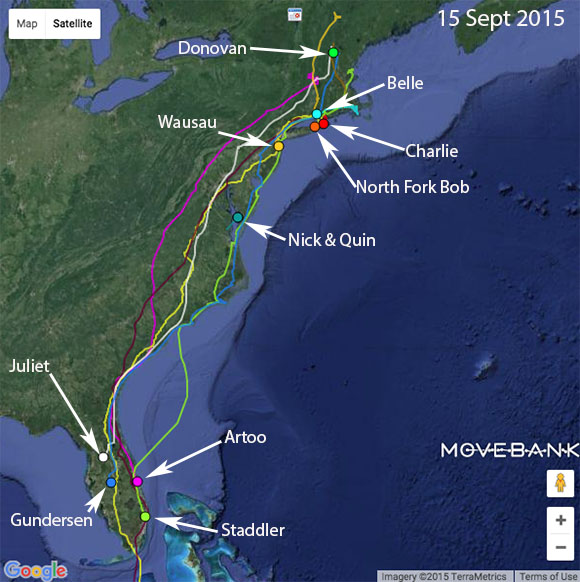 The cool, crisp weather and north winds have convinced a few more birds to get moving. Wassau left his nest area in central New Hampshire on the 11th and is now in northern New Jersey. He might get counted at the Cape May Hawk Watch in a day or so. Belle got going on the 15th, four days earlier than her start back in 2014.
The cool, crisp weather and north winds have convinced a few more birds to get moving. Wassau left his nest area in central New Hampshire on the 11th and is now in northern New Jersey. He might get counted at the Cape May Hawk Watch in a day or so. Belle got going on the 15th, four days earlier than her start back in 2014.
We've got four New Hampshire birds in Florida now: Artoo (2013 juvie on 2nd trip south), Staddler and Gundersen (newly tagged adult males), and Juliet (newly tagged juvie on her 1st trip south. Our other New Hampshire bird, Donovan, is going for the "last one out, turn off the lights" award.
Around Long Island Sound, Charlie (Fishers Island male) is spending a lot of time on Gardiners Island, just as he did last year before taking off, so I suspect he'll leave soon. North Fork Bob seems to like his new nest and can't seem to tear himself away from it. They should both leave soon(ish).
Our two veteran males from the lower Chesapeake Bay (Nick and Quin) have been staying very close to home. They started south last year on the 18th and 26th, respectively.
2 September 2015:
Our first bird is across the Caribbean--well almost across. When he downloaded (at 1:30 PM on 2 Sept) he was 10 miles from the Colombian coast. He left the D.R. at 6:28 PM on the 1st and 19 hours later had covered 386 miles, which is almost exactly 20 mph (33 kph). The crossing was made "down on the deck." His average altitude on the crossing was 17 m (51 feet). Only once was more than 30 m over the water.
1 September 2015:
Sadly we lost our very interesting juvenile, Lizzie, probably to electrocution. She was found right below some high tension wires near her adopted nest. Details on the New England page.
24 January 2015:
It's not usual to get a surprise in the middle of the winter. At least it wasn't when we had only satellite transmitters on our Ospreys. Now that some of our birds carry cell-tower transmitters, we occasionally have birds pop up after long silences when they wander into an area with celll tower coverage. This is what happened with Crabby, a female we tagged on Kent Island in Chesapeake Bay last spring.
In the fall, Crabby migrated to the northeastern coast of South America. She arrived in French Guiana on October 4th. It looked like she was going to settle down there. Then, just a day later, we stopped getting signals from her. I was worried because it did look like she had settled down, so we shoud have continued to get sporadic messages from her over the course of the winter. She was on the outskirts of Cayenne, the capitol of French Guiana. So that suggested cell coverage should be good, but it also meant she might have a high likelihood of being shot.
After 3 months with no signals, I assumed she was dead or had just moved to a spot without cell coverage (there's much more down in South America than one would expect). In either case, we probably would have to wait until spring when she either showed up again somewhere along her migration route, or just never reappeared, which would have meant something had happened to her.
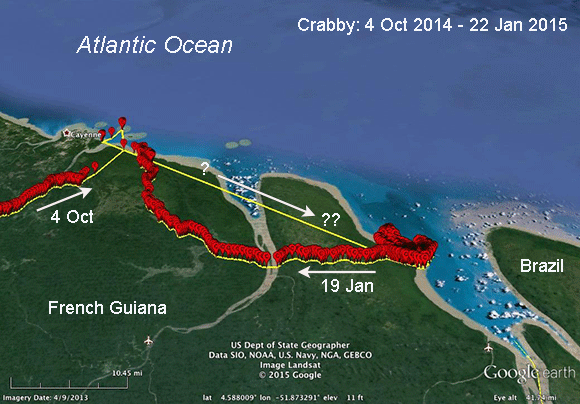
So it was a nice surprise to get an email with data from a transmitter number I didn't recognize. (Each message from a cell-tower bird has the ID of the bird.) It had been so long since I'd heard from her that I had to look up the number.
We're missing some data. We don't have any locations from Oct 6th through Dec 20th, so we don't know when she moved down, but from at least the 20th of December to th 19th of January, she was along the coast 50 mi. (80 km) southeast of Cayenne and 10 miles west of Brazil's northernmost state of Amapa.
14 November:
This map begins on 1 October. At that time, Artoo (juvenile tagged in 2013) was moving around a bit, but basically settled down (he'll come back next spring), Snowy (MVY bird from 2011) had returned to her winter range from 2011-2012, Woody was back west of Lake Maracaibo in Venezuela, Clyde (2014 young from Long Island) seems to have settled down on the eastern shores of the Gulf of Venezuela, and Bridget is showing all signs that she thinks Vero Beach, FL, is a good place to spend the next 18 months.
Flow (2014 juvenile from Essex, MA) hadn't really started migrating with any conviction yet and was still up around Chesapeake Bay, North Fork Bob (always a late starter in the fall) was in western Cuba, Belle (tagged as a juvenile on Martha's Vineyard in 2010), Charlie (Fishers Island adult male tagged in 2014), and Ron (adult male tagged in Washington, DC in 2013) were all within about 80 miles of each other in southeastern Cuba.
By 14 November, it seems almost everyone has settled down for the winter. North Fork Bob did his usual thing of stopping for a while in the flooded grasslands (llanos) of central Venezuela. He's now moving up into the highlands of the Guiana Shield, where he has spent all his previous winters along the Ventuari River. His radio missed a few transmissions, so I won't be surprised if we lose track of him like we did last year with his 2010 Classmate Sr. Bones. The youngsters (Bridget, Flow, and Clyde) may move again, but I'd be very surprised if they make any major moves south.
